Over the years, hangars have developed from large sheds to architectural masterpieces, the latter being driven by state owned airlines wanting a statement building at the country’s international airport in the capital city and by the Airbus A380, simply through the building having to accommodate such a large aircraft.
That trend has now reversed, with increasing emphasis on simpler designs and concern for the environment, as can be seen by the activities of some of the industry’s major players.
Jewers Doors
Jonathan Jewers, director at Jewers Doors, says the market for commercial MRO hangars has ‘fallen off a cliff’ as a result of COVID. However, there has been strong demand from the military and for the company’s non-aviation industrial doors, used in buildings such as fire and ambulance stations and railway and metro depots.
A recent military contract was for Calidus in Abu Dhabi, which has developed the B-240 light attack aircraft, 24 of which have been ordered by the United Arab Emirates armed forces. These are being prepared in a new Flight Preparation and a Flight Assembly facility at Al Ain International Airport facility that was completed in 2020. This features two hangars, each with a set of Esavian Type 126 sliding doors measuring 30m wide by 5.6m high and fully clad with insulated flat sandwich panel cladding. The doors have six leaves that are electrically operated, with three sliding to each side of the hangar.
One bright spot has been new maintenance facilities for business aviation, which has experienced an upturn as the wealthy have looked for alternatives to commercial airlines during the pandemic.
Another 2020 project was to supply and install three sets of Esavian Type 126 doors for a 20,900m² Customer Support Service Centre for Gulfstream Aerospace Corporation at Farnborough Airport in the UK. The new facility can easily accommodate 13 large-cabin aircraft and offers maintenance, repair and overhaul services, as well as interior refurbishments and aftermarket modifications. Each of the three door consists of four door leaves, each 16.98m wide, to close off the clear opening of 67.4m wide by 9.25 m high. Each leaf, which is fitted with a continuous band of double-glazed windows at eye level, can move independently of each within the opening to allow multiple aircraft movements in and out of the hangars.
Currently, the company is supplying doors to Execujet’s prestigious new hangar at Dubai South, also a further nine sets of Esavian Type 126 doors for the Turkmenistan Presidential Code C (narrowbody) and Code F (general aviation) hangars at Ashgabat Airport.
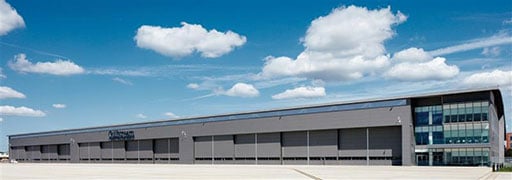
Jewers says he has noticed some promising movement in the market recently, with tenders for new hangars in Europe and Asia but also for the refurbishment of existing facilities.
Some of the new hangar projects may benefit from a change in regulations that does away with the requirement for a foam system for fire suppression if they are less than 4,500m². Another notable design trend is a new emphasis to incorporate sustainability and reduced life-cycle operating costs, he adds, although some are calling for semi-permanent fabric structures as opposed to conventional hangar designs, although a part of this is may be to show the building as equipment on the books, rather than an asset. Other trends include rainwater harvesting, solar panels on the roof and airtight door seals and improved thermal insulation to retain heat better.
His own company is no exception. It moved into a new purpose-built facility in June this year, with 4,245m² of factory space and a 1,115m² headquarters building. The new facility is highly insulated with energy efficient heating and cooling systems in both the factory and offices. The offices have a heat recovery system which maintains fresh air around the building while minimising heat loss. There are over 200m² of photovoltaic panels on the roof capable of generating over 42kW of power and with plenty of space to expand in the future. Excess electricity can be sold back into the National Grid. Low energy sensor controlled LED lights are fitted throughout factory — there are no light switches. Also, there are 8 EV charging points for employees in anticipation of the uptake in electric and hybrid vehicles and with provision to easily increase this number in the future.
Buildair
Felipe Cano, sales director at Buildair is also very aware of the trends towards sustainability and fabric buildings.
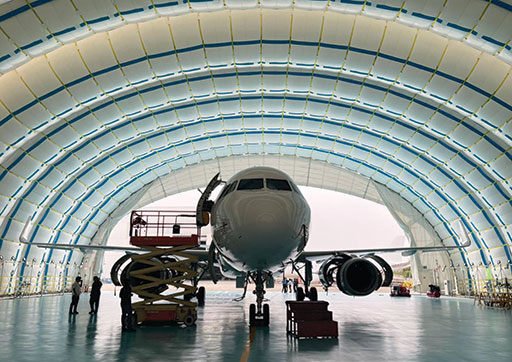
The Spanish company specializes in inflatable hangars, formed by linking together identical inflated tubes made from fire retardant PVC-covered fabric. These are kept constantly inflated at a relatively low pressure of 20-30mb by two independent electric motors. The company has now improved the design to retain that pressure, which it calls AIRTIGHT, which means the motors are only required when the Automatic Control System detects a pressure drop. The system also performs real-time tracking of wind speed and fire detection, with alerts being sent to a computer or smartphone. To further reduce energy needs, the motors can be powered by batteries charged by solar panels if required.
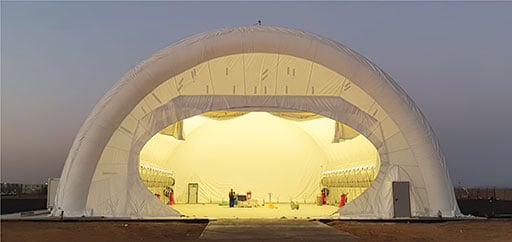
The hangars use high-resistance anchorage systems instead of traditional foundation works, enabling them to be relocated if required.
A recent project, delivered in May this year, was a hangar in Hyderabad, India, for GMR Aero Technic. The building, designed for a single Airbus A320 Family or Boeing 737, measures 62m long with a 45m clear width, giving 2,800m² of useful space, without any interior columns. The 18m clear height allows the aircraft to be jacked for undercarriage removal and testing It is fitted with an inflatable door.
Cano says India is set to become a major market as the government recently reduced the tax level on MRO work. Airlines are expected to bring their aircraft back home as a result, so there could be an urgent need for extra hangar space. The Hyderabad hangar was delivered with a lead time of just 3.5 months. He points that the door is important, as FAA and EASA make it a mandatory requirement in approving maintenance facilities, and Indian MROs may want to follow that route in expanding their customer base.
Back home, the company delivered two buildings to Lleida-Alguaire International Airport in Catalunya. This is a major location for aircraft storage and disassembly. The shelters, one measuring 25m wide, the other 20m They are used to maintain small aircraft and pilot training aircraft.
The latest project, using AIRTIGHT technology and delivered in August, is a hangar for The Helicopter Company of Saudi Arabia in Jeddah. It has a length of 46m and a clear width of 20m, giving a useful area of 920 m², and 10m clear height.
Jeddah is also the location of another Buildair hangar, this time at the opposite end of the size scale. Delivered in 2019 to Saudia Aerospace Engineering Industries (SAEI), a subsidiary of Saudia Airlines, it has a length of 80m and 75m clear width, giving a 6,000 m² covered area, while the 26m interior height allows an Airbus A330 or Boeing 777-200 ER to be jacked. It is the world’s largest inflatable building.
Away from aviation, he is seeing increasing interest from the offshore wind farm industry. Being able to quickly construct a temporary facility at a nearby coastal location is a distinct advantage, whether for construction or repair and overhaul — a 25m wide shelter can be packed into a single 20ft ISO container and erected in six hours. That also has attractions for disaster relief operations.
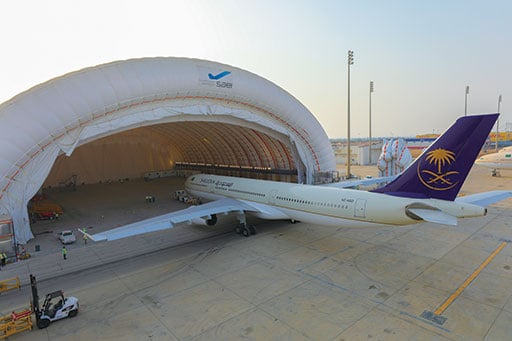
Rubb Buildings
Ryan Clarke, sales executive at Rubb Buildings, says there was a shortage of hangar space for maintenance before the pandemic struck. As the situation gets back to normal, the demand will only increase further, which means unconventional structures will have an advantage if they can offer shorter lead times. His company uses a steel structure clad with high-strength, heavyweight coated architectural membranes from Serge Ferrari, combined with Rubb’s own Thermohall cladding for insulation. This means a narrowbody hangar can be designed and built in six-eight months.
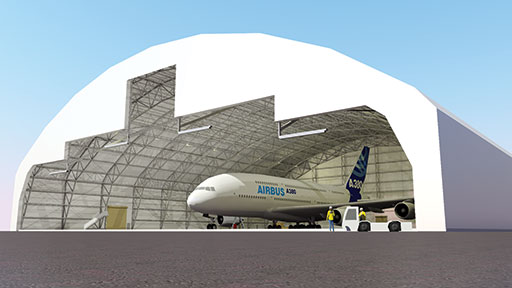
The latest project, commissioned in September, is located in the Bro Tathan Business Park in Wales. This new development sits on the edge of the former RAF St Athan base and is designed to attract MRO organizations by having direct runway access. The hangar was ordered by the Welsh Government and is intended to be used by new arrivals while their own facility is being constructed.
With a length and width of 50m and an apex height of 18.5m, it can accommodate a single Airbus A320 Family or Boeing 737 aircraft. The structure includes 150mm Thermohall cladding and an Assa Abloy Megadoor vertical lifting fabric door with a clear width of 42m and overall clear height of 13.5m (Megadoor is Rubb’s preferred supplier for vertical doors, Jewers for sliding doors, notes Clarke). The hangar also features a 500 lux LED lighting system, electric radiant heating, and a full HVAC system.
A previous project, in 2019, was a large MRO hangar for Turkish Technic at the new Istanbul International Airport. Measuring 82.3m long by 87.5m wide and a height of 9.8m, it has 50mm Thermohall cladding, as temperatures are higher than at Bro Tathan, and a 71.9m by 19.8m Megadoor vertical door. The size of the hangar meant that 12,000m² of Thermohall cladding and 32,000m² of Precontraint 412 and Precontraint 832 fabric from Serge Ferrari were needed. The hangar is a temporary structure — when the main MRO facility is completed, it will be dismantled and moved to another airport.
Rubb Buildings is part of Rubb Industries, which helped with the installation but the project involved Rubb UK in the early sales process and securing the contract, Rubb Poland produced the Thermohall cladding, Rubb Norway provided the advanced Tekla program modeling and Rubb USA engineered and oversaw the project.
The project generated a lot of interest says Clarke, and raised Rubb’s profile in the market. One result was a contract awarded in June to build an A380 capable hangar, measuring 300ft by 300ft and 40ft high, using a 10-span hot-dip galvanized steel frame. This will be equipped with a five panel vertical lift Megadoor system with pivoting mullions. There will also be a 12ft x 12ft electrically operated roller shutter door and four 3ft x 7ft pedestrian doors fitted with panic hardware for emergency stops and vision windows.
The customer and location have not been disclosed.
Closer to home, the company last year added a third bay alongside a two bay hangar at London Gatwick for easyJet. Although the extra bay could have been simply added to the existing building, the lay of the land meant there was a 10m gap, so walkways were installed to provide easy access.
As mentioned, Rubb is part of Rubb Industries AS, which operates in a number of industry sectors. Drawing on that experience, it was able to come up with an innovative scheme for aviation — the leasing of buildings. In this case, it was a 25m x 24m hangar which was supplied to a helicopter company for six months while it carried out a project. It will then be dismantled ready for the next customer.
Clarke comments that the demand for new hangars is coming from the Middle East and Central Europe, especially for A350/777 size facilities but there is also interest, for the first time, in paint shops, helped by improved door seals. As for sustainability, he says all the PVC and steel can be recycled.
Champion Door
Pekka Hosio, CEO and founder of Champion Door in Finland, says his company’s products are completely recyclable, being constructed of fabric covers over an aluminium and steel structure with one or two insulation layers depending on customer choice and their climatic conditions.
At the moment, he is seeing greatest demand from the military market, for new and refurbished hangars ranging size from helicopters through fighters to transport aircraft, although Eastern Europe has seen an increasing number of companies purchasing their own aircraft as a way of avoiding the complications of reduced airline activity and rapidly changing schedules. As a consequence, they also need a hangar.
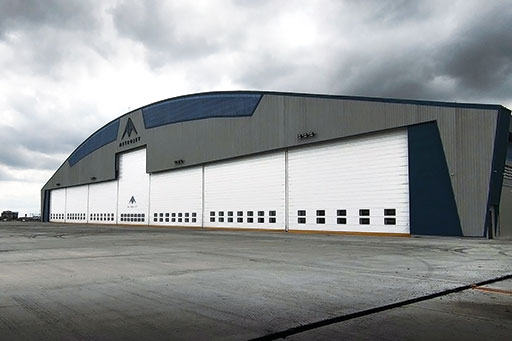
One business aviation project further afield was the opening in May this year of a maintenance hangar for Hong Kong-based Metrojet at Clark in the Philippines. The building is 110m wide by 63m deep, with over 7,100m² of floor space, and 21.5m high. Five vertical lift Champion doors, each independently movable, cover a clear space of 100m x 16m. The hangar can accommodate up to 10 long range business jets such as Airbus Corporate Jets and Boeing Business Jets, while a 2500m² two-storey annex building at the rear of the hangar with workshops, stores, staff and customer offices and lounges with available space for a dedicated Fixed-Base Operator (FBO). There is 11,000m² of apron space in front of the hangar with an exclusive private taxiway. The facility, with the doors, has been designed to the highest international standards including typhoon and seismic loadings.
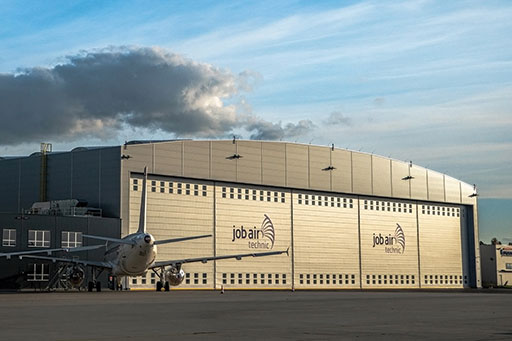
Closer to home, the company supplied its NK4 Warm doors, the highest thermal rating, to a new two-bay narrowbody that opened in February 2020 at JOB AIR Technic MRO hangar in Ostrava, Czech Republic.
In 2019, it worked with French construction company MAS BTP on a hangar extension at Airbus in Toulouse. The extension at the front of an existing Beluga ST hangar used doors measuring 65m in width and with a maximum height of 24m, enabling the hangar to be used by the larger Beluga XL.
Talking of standards, the company has been involved for four years in helping to update the UFGS-08 34 16.20 specification of the US Naval Facilities Engineering Systems Command (NAVFAC). These are regarded as the world’s most detailed and strictest guide for fabric fold-up doors. The revised specification now includes technology that has been used for a long time by Champion Door in all its doors, in aviation, shipbuilding and industrial applications.
Hosio points out that fabric lift doors work well in hot conditions, where the tightness of the fabric keeps heat, sand and dust away from the building and from disturbing work. Unlike traditional lift door solutions, no dust or dirt can accumulate on the ends of the Champion Door’s door side rails or door joints, which could, in the worst case, stop the door from working.
They are also suited to cold conditions — the company is Finnish, after all — where traditional door solutions may have difficulties. Fabric doors do not freeze or jam, even if there is ice and snow around while heat stays inside.
A good example is from Widerøe, the Norwegian regional airline, that has hangars at Kirkenes and Vadsø. These have been equipped with three-piece NK4 Warm and NK2 doors since 2005 and 2011 respectively. Both airports are around 400km north of the Arctic Circle and winter often brings sudden large temperature drops, huge masses of snow and strong, violent winds. The most important job for the doors, which are opened several times a day, all year round, is to keep the snow and wind out but they must also keep the hangar warm for personnel and the aircraft protected from the weather. This is particularly important if there is a need for urgent maintenance or repairs, which can be carried out at Kirkenes — Vadsø is for parking only. Kirkenes also carries out deicing operations in the hangar, so those doors may be used more often.
